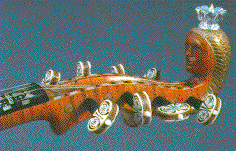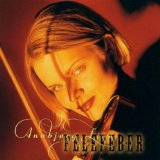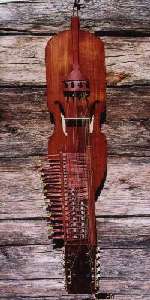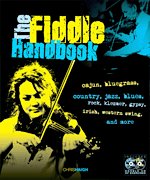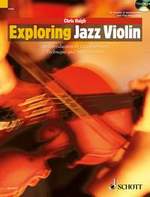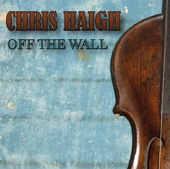
MENU TO FIDDLE STYLES:
Scandinavian fiddle
In Scandinavia the fiddle is quite literally the stuff of legend. The wild landscape of air, rock , forest and water is reflected with crystal clarity in the bleak majesty of the music, and tales abound of the supernatural link between the fiddler and the twilight world of devils, sprites and trolls.
Hardingfele
The Norwegian folk tradition centres around its unique national instrument, the Hardanger fiddle or hardingfele, thought to have been first developed as early as 1650. The oldest known instrument is the famous Jaastad fiddle, dated 1651). The earliest Hardanger fiddles were much smaller than either the modern hardanger fiddles or standard violins, and they were more rectangular in shape. The most significant difference between the Hardinfele today and the standard violin is the presence of four or five sympathetic strings which run under the fingerboard. These ring freely whilst the fiddle is being played providing eerie drones, harmony and sometimes unexpected dissonance, apparently above and beyond the control of the fiddler. Because the pegbox is longer than on a violin, the neck is shorter, so that playing is laregly confined to the lower positions. The bridge and fingerboard are also flatter to facilitate double and triple stopping. The body is richly decorated with black ink (a technique called rosemalling); the fingerboard and tailpiece are inlaid with mother-of-pearl, and the headstock is carved into the shape of a maiden, dragon or lion's head
There are over 26 different tunings for the hardingfele, each of which has a unique voice and leads to a different set of tonal possibilities. Just as individual raags are associated with particular times of the day, so hardingfele tunings take on a semi-mystical quality, with names such as "twilight grey", light blue and "half-troll tuning". A few common examples include ADAE (oppstilt or hØgbass.);GDAD (spakrostilt); DDAE (Lausbas- loose bass); or AEAE (halvt-trollstilt). Be careful with AEAC# (Nackastamning)- this is the devil's own tuning! The sympathetic strings on the hardingfele are retuned depending on the main strings, but the standard tuning is (B)DEF#A which, surprise surprise, gives the opening phrase of Greigs's Morning from Peer Ghynt!
The hardingfele is often tuned rather higher than standard pitch to accentuate the bright ringing effect. Many tunes also use a non-standard scale including quarter-tones; this may be an ancient inheritance from the primitive selje floyte (a one-holed willow flute) which appears to have a natural rather than man-made register. That these eccentricities have survived is partly due to the fact that the hardingfele is traditionally a solo instrument and has not had to face up to the teutonic tyranny of the accordion; also the natural barriers of mountain, fjord and forest have effectively kept many communities quite isolated until recently, allowing local styles to thrive and diversify.
The best collection of Hardanger fiddles today is found at the Folk Museum in Utne on Hardanger Fjord.
Probably the greatest hardingfele player Norway has known was Myllargurtan ("Miller's Boy", who from 1830 to 1850 dedicated his life to travelling the country learning and exchanging tunes, embroidering and personalising them in a remarkable way, and bringing the instrument for the first time to the concert hall . It was he who introduced the idea of lydarslater- tunes for listening rather than dancing.
The West of Norway was hit by famine around 1850 and , as in Ireland, there was a great emigration, particularly to America. As a result a strong hardingfele tradition became established, and still survives, in the USA.
In 1923 the Norwegians realised that their musical traditions were in danger of declining, and a deliberate revival was started. and classical music students were encouraged to learn hardingfele alongside the standard violin. Government support for folk music remains strong in Norway to this day.
One of the most influential players currently is AnnbjØrg Lien , who works with her group Bukkene Bruse. Knut Buen and Hallvard T Bjorkum are other fine players. You can hear Knut Buen in an interesting "experimental pagan folk metal" context (yes, such a thing does exist!) on the album Grimen with the band Hardingrock.
You can also hear the Irish fiddler Dermot Crehan playing hardingfele on the soundtrack of The Lord of The Rings (The Two Towers). The instrument takes the main theme for the Rohirrim- the blue-eyed, blonde haired horsemen (Norsemen?) of Rohan.
AnnbjØrg Lien
Legends
Some hardingfele tunes are rhythmically very complex. The springar, though basically in 3/4, appears virtually impenetrable, with beats which vary widely in length; it is nevertheless a dance tune and is accompanied by foot stamping. More accessible are the different types of walking tune, from the slow march to the gangar, a steady 2/4 or 6/8. The halling is another 2/4 tune, played for a solo dance where a man attempts to leap high enough to kick a hat off a stick held by a girl. The origin of some of these old tunes is cloaked in legend. One tale tells of the Fossegrimmen, a water sprite that lives in a waterfall, who will teach you a tune in excahnge for a leg of lamb thrown into the torrent. If the lamb isn't thought to be of suffiecient quality, all you'll get is the ability to tune your fiddle. Another tells of the troll or Nacken who lives in lakes and streams; if you hang your fiddle overnight under a bridge where he lives, the troll will retune your fiddle and play a tune on it, finally leaving his own instrument next to it. If on returning you pick up your own fiddle, the troll's tune and supernatural touch will be yours. If by mistake you pick up the troll's fiddle, your soul is his forever!
Rammeslatter are tunes which, because of their hypnotic quality can put player and listener alike into a state of trance; the fiddler will play, unable to stop, until someone drags the fiddle from his hands. Julane Lund, a fiddler who studied traditional arts at Telemark University, has recently studied this phenomenon and finds it to be both real and observable; the player himself will often come out of the trance feeling exhasted, and having no memory of playing. Legend says that fanitullen, the devil's tune, was first played by the man himself who appeared, hooves and all, at a village dance. He grabbed the fiddle and began playing a tune so wonderful that the gathered people continued dancing until they died from exhaustion- and then their corpses continued dancing until their skulls rolled out of the door and down the hill!
Another group of tunes, the Gammeldans, were imported from Sweden in the 19th century; these tend to be more predictable and less mysterious and melancholy. The mazurka has a bouncy 3/4 rhythm (eg. Brage Gilles Mazurka ); a similar dotted rhythm, but in 4/4 is found in the schottische (eg. Schottis fran (from) Lima .) Polkas, (not to be confused with polskas) and Reinlenders have a jolly 2/4 rhythm. Sweden has its equivalent to the walking tunes of Norway, including the brudmarsch (wedding march) and the ganglat. Gardeby Laten is a ganglat so often played that people sing along with it words which mean "aren't you sick of this tune yet?". Also well known is Appelbo Ganglat . Probably the most important group of Swedish tunes are the polskas. These have a 3/4 rhythm with stress on the first and third beats; the emphasis of these beats varies considerably from region to region. Polskas, and indeed many Scandinavian tunes, are often named after a revered fiddler from the past whose playing defined a particular tune, though he is unlikely to have actually written it; for example Polska efter (after) Karl Linblad, or Polska e. Per Osa . Very useful for the fiddler is the skanklåt- an "I want to get paid " tune which reminds the guests at a wedding that the poor musician has been playing for five hours, hasn't been offered any sandwiches, hasn't been paid, and wants to go home. Most of the above Swedish and gammeldans tunes are played on the normal fiddle (called flatfele in Norway), often in ensembles with other instruments such as accordion, recorder, or fattigmannsfele (poor man's fiddle)- the jew's harp. Spellmannslag are large groups of fiddlers who meet regularly to learn, play for enjoyment, and maintain the tradition.
Nyckelharpa
Sweden has its own unique fiddle in the Nyckelharpa. This has tangents, acting like frets which can be raised or lowered with keys instead of fingering the notes directly onto the fingerboard. In the modern chromatic version of the instrument there are three melody strings, one drone string and twelve sympathetic strings. The instrument has a 3 octave range.
Held like a guitar, a short bow is wielded with the right hand whilst the left hand operates the keys. Though with a history going back almost 600 years, the nyckelharpa had almost died out by the 20th century (there were just fourteen players left in the 1960's!), but it was revived largely due to the efforts of Eric Sahlstrom (1912-86). One of the best known players today is Olov Johansson , who plays solo and with his group Vasen. The normal fiddle is extremely popular in Sweden; it is said that if you meet two people from Rattvik (In central Sweden), three of them play the fiddle! Hjort-Anders (1863-1952) was a legendary fiddle player who had the habit of walking into a crowded church on a sunday and playing a demon version of the Devil's Polska, just to annoy people. While Norway today tends to be quite traditionalist and introspective musically (with notable exceptions, such as the elemental Utla, mixing hardingfele, sax, drums and jews harp), Sweden has produced many internationally known bands which experiment with interesting fusion- notably Filarfolket (now disbanded), Groupa (featuring fiddler and composer Mats Eden ), Frifot, Hedningarna and Hoven Droven, whilst Finland, another fiddle-loving nation, has Varttina, and the massed fiddles of JPP.
_______________________________________________________________________________
Links:
AnnbjØrg Lien homepage
The Hardanger Fiddle Association of America (HFAA)
Swedish Traditional Music page (includes musical examples of different types of polska)
Lennart Sohlman's Swedish Fiddle Site
_______________________________________________________________________________
RETURN TO FIDDLINGAROUND HOMEPAGE
